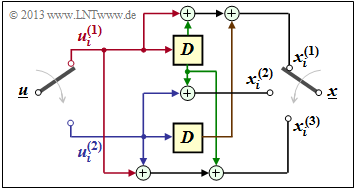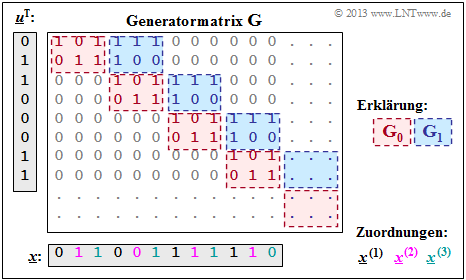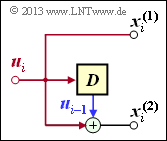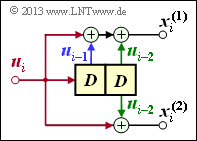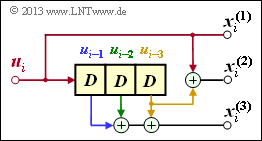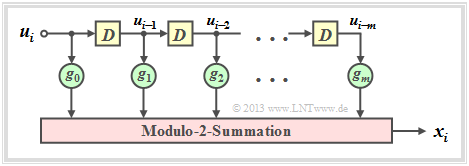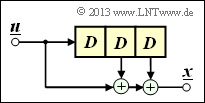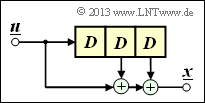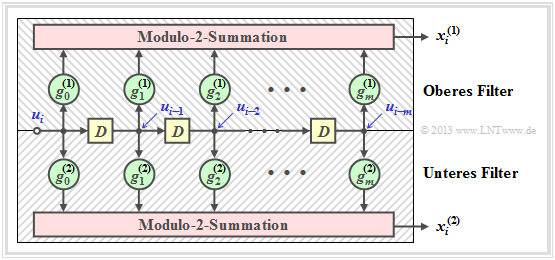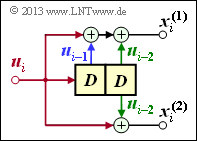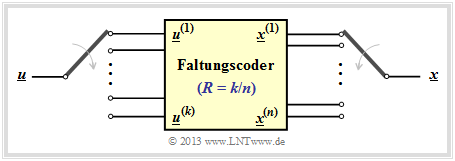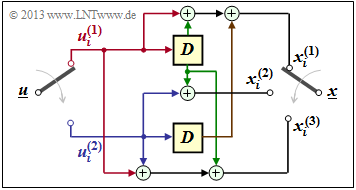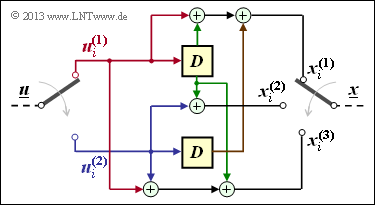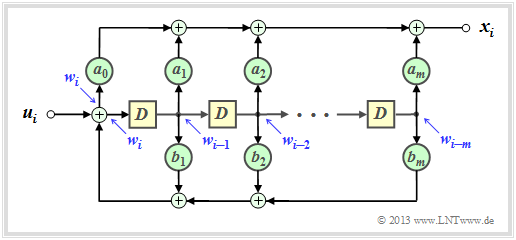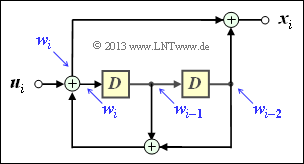Difference between revisions of "Channel Coding/Algebraic and Polynomial Description"
| Line 84: | Line 84: | ||
{{GraueBox|TEXT= | {{GraueBox|TEXT= | ||
$\text{Example 2:}$ | $\text{Example 2:}$ | ||
| − | + | With the two matrices $\mathbf{G}_0$ and $\mathbf{G}_1$ – see [[Channel_Coding/Algebraic_and_Polynomial_Description#Division_of_the_generator_matrix_into_partial_matrices| $\text{"Example 1"}$]] – the matrix sketched on the right $\mathbf{G}$ is obtained. | |
| − | + | It should be noted: | |
| − | * | + | *The generator matrix $\mathbf{G}$ actually extends downwards and to the right to infinity. Explicitly shown, however, are only eight rows and twelve columns. |
| − | * | + | *For the temporal information sequence $\underline{u} = (0, 1, 1, 0, 0, 0, 1, 1)$ the drawn matrix part is sufficient. The code sequence is then: |
:$$\underline{x} = (0, 1, 1, 0, 0, 1, 1, 1, 1, 1, 1, 0).$$ | :$$\underline{x} = (0, 1, 1, 0, 0, 1, 1, 1, 1, 1, 1, 0).$$ | ||
| − | * | + | *On the basis of the label colors, the $n = 3$ codeword strings can be read. |
| − | * | + | *We got the same result (in a different way) in the [[Channel_Coding/Basics_of_Convolutional_Coding#Convolutional_encoder_with_two_inputs| $\text{"Example 4"}$]] at the end of the last chapter: |
:$$\underline{\it x}^{(1)} = (0\hspace{0.05cm}, 0\hspace{0.05cm}, 1\hspace{0.05cm}, 1) \hspace{0.05cm},\hspace{0.5cm} | :$$\underline{\it x}^{(1)} = (0\hspace{0.05cm}, 0\hspace{0.05cm}, 1\hspace{0.05cm}, 1) \hspace{0.05cm},\hspace{0.5cm} | ||
\underline{\it x}^{(2)} = (1\hspace{0.05cm}, 0\hspace{0.05cm},1\hspace{0.05cm}, 1) \hspace{0.05cm},\hspace{0.5cm} | \underline{\it x}^{(2)} = (1\hspace{0.05cm}, 0\hspace{0.05cm},1\hspace{0.05cm}, 1) \hspace{0.05cm},\hspace{0.5cm} | ||
\underline{\it x}^{(3)} = (1\hspace{0.05cm}, 1\hspace{0.05cm}, 1\hspace{0.05cm}, 0) \hspace{0.05cm}.$$}}<br> | \underline{\it x}^{(3)} = (1\hspace{0.05cm}, 1\hspace{0.05cm}, 1\hspace{0.05cm}, 0) \hspace{0.05cm}.$$}}<br> | ||
| − | == | + | == Generator matrix for convolutional encoder of rate 1/''n'' == |
<br> | <br> | ||
| − | + | We now consider the special case $k = 1$, | |
| − | * | + | *on the one hand for reasons of simplest possible representation, |
| − | * | + | *but also because convolutional coders of rate $1/n$ have great importance for practice.<br><br> |
| − | [[File:P ID2602 KC T 3 2 S3a.png|right|frame| | + | [[File:P ID2602 KC T 3 2 S3a.png|right|frame|Convolutional encoder with $k = 1, \ n = 2, \ m = 1$]] |
| − | <b> | + | <b>Convolutional encoder with $k = 1, \ n = 2, \ m = 1$</b><br> |
| − | + | From the adjacent sketch can be derived: | |
::<math>{ \boldsymbol{\rm G}}_0=\begin{pmatrix} | ::<math>{ \boldsymbol{\rm G}}_0=\begin{pmatrix} | ||
| Line 123: | Line 123: | ||
\end{pmatrix}\hspace{0.05cm}.</math> | \end{pmatrix}\hspace{0.05cm}.</math> | ||
| − | + | For the input sequence $\underline{u} = (1, 0, 1, 1)$ the code sequence starts with $\underline{x} = (1, 1, 0, 1, 1, 1, 1, 0, \ \text{...})$. <br>This result is equal to the sum of rows 1, 3 and 4 of the generator matrix.<br><br> | |
| − | [[File:P ID2603 KC T 3 2 S3b.png|right|frame| | + | [[File:P ID2603 KC T 3 2 S3b.png|right|frame|Convolutional encoder with $k = 1, \ n = 2, \ m = 2$]] |
| − | <b> | + | <b>Convolutional encoder with $k = 1, \ n = 2, \ m = 2$</b><br> |
| − | + | Due to the memory order $m = 2$ there are three submatrices here: | |
::<math>{ \boldsymbol{\rm G}}_0=\begin{pmatrix} | ::<math>{ \boldsymbol{\rm G}}_0=\begin{pmatrix} | ||
| Line 140: | Line 140: | ||
\end{pmatrix}</math> | \end{pmatrix}</math> | ||
| − | + | Thus, the resulting generator matrix is: | |
::<math> { \boldsymbol{\rm G}}=\begin{pmatrix} | ::<math> { \boldsymbol{\rm G}}=\begin{pmatrix} | ||
| Line 150: | Line 150: | ||
\end{pmatrix}\hspace{0.05cm}.</math> | \end{pmatrix}\hspace{0.05cm}.</math> | ||
| − | + | Here the input sequence $\underline{u} = (1, 0, 1, 1)$ leads to the code sequence $\underline{x} = (1, 1, 1, 0, 0, 0, 0, 1, \ \text{...})$.<br><br> | |
| − | [[File:P ID2604 KC T 3 2 S3c.png|right|frame| | + | [[File:P ID2604 KC T 3 2 S3c.png|right|frame|Convolutional encoder with $k = 1, \ n = 3, \ m = 3$]] |
| − | <b> | + | <b>Convolutional encoder with $k = 1, \ n = 3, \ m = 3$</b> |
| − | + | Because of $m = 3$ there are now four partial matrices of the respective dimension $1 × 3$: | |
::<math>{ \boldsymbol{\rm G}}_0=\begin{pmatrix} | ::<math>{ \boldsymbol{\rm G}}_0=\begin{pmatrix} | ||
| Line 170: | Line 170: | ||
\end{pmatrix}\hspace{0.05cm}.</math> | \end{pmatrix}\hspace{0.05cm}.</math> | ||
| − | + | Thus, the resulting generator matrix is: | |
::<math>{ \boldsymbol{\rm G}}=\begin{pmatrix} | ::<math>{ \boldsymbol{\rm G}}=\begin{pmatrix} | ||
| Line 180: | Line 180: | ||
\end{pmatrix}\hspace{0.05cm},</math> | \end{pmatrix}\hspace{0.05cm},</math> | ||
| − | + | and one obtains for $\underline{u} = (1, 0, 1, 1)$ the code sequence $\underline{x} = (1, 1, 0, 0, 0, 1, 1, 1, 1, 1, 0, 0, \ \text{...})$.<br> | |
| − | == GF(2) | + | == GF(2) description forms of a digital filter == |
<br> | <br> | ||
| − | [[File:P ID2605 KC T 3 2 S4 v1.png|right|frame| | + | [[File:P ID2605 KC T 3 2 S4 v1.png|right|frame|Digital filter in ${\rm GF}(2)$ of order $m$|class=fit]] |
| − | + | In the chapter [[Channel_Coding/Basics_of_Convolutional_Coding#Rate_1.2F2_convolutional_encoder| "Basics of Convolutional Coding"]] it was already pointed out, | |
| − | * | + | *that a rate $1/n$ convolutional encoder can be realized by several digital filters, |
| − | * | + | *where the filters operate in parallel with the same input sequence $\underline{u}$ . |
| − | + | Before we elaborate on this statement, we shall first mention the properties of a digital filter for the Galois field ${\rm GF(2)}$ . | |
| − | + | The graph is to be interpreted as follows: | |
| − | * | + | *The filter has impulse response $\underline{g} = (g_0, g_1, g_2, \ \text{...} \ , g_m)$. |
| − | * | + | * For all filter coefficients $($with indices $0 ≤ l ≤ m)$ holds: $g_l ∈ {\rm GF}(2) = \{0, 1\}$.<br> |
| − | * | + | *The individual symbols $u_i$ of the input sequence $\underline{u}$ are also binary: $u_i ∈ \{0, 1\}$. |
| − | * | + | *Thus, for the output symbol at times $i ≥ 1$ with addition and multiplication in ${\rm GF(2)}$: |
::<math>x_i = \sum_{l = 0}^{m} g_l \cdot u_{i-l} \hspace{0.05cm}.</math> | ::<math>x_i = \sum_{l = 0}^{m} g_l \cdot u_{i-l} \hspace{0.05cm}.</math> | ||
| − | * | + | *This corresponds to the (discrete time) [[Signal_Representation/The_Convolution_Theorem_and_Operation#Convolution_in_the_time_domain| "convolution"]] , denoted by an asterisk. This can be used to write for the entire output sequence: |
::<math>\underline{x} = \underline{u} * \underline{g}\hspace{0.05cm}.</math> | ::<math>\underline{x} = \underline{u} * \underline{g}\hspace{0.05cm}.</math> | ||
| − | * | + | *Major difference compared to the chapter [[Theory_of_Stochastic_Signals/Digital_Filters| "Digital Filters"]] in the book "Theory of Stochastic Signals" is the modulo 2 addition $(1 + 1 = 0)$ instead of the conventional addition $(1 + 1 = 2)$.<br><br> |
| − | [[File:P ID2606 KC T 3 2 S4b.png|right|frame| | + | [[File:P ID2606 KC T 3 2 S4b.png|right|frame|Digital filter with impulse response $(1, 0, 1, 1)$]] |
{{GraueBox|TEXT= | {{GraueBox|TEXT= | ||
| − | $\text{ | + | $\text{Example 3:}$ |
| − | + | The impulse response of the third order digital filter shown is: $\underline{g} = (1, 0, 1, 1)$. | |
| − | * | + | *Let the input sequence of this filter be unlimited in time: $\underline{u} = (1, 1, 0, 0, 0, \ \text{ ...})$.<br> |
| − | * | + | *This gives the (infinite) initial sequence $\underline{x}$ in the binary Galois field ⇒ ${\rm GF(2)}$: |
::<math>\underline{x} = (\hspace{0.05cm}1,\hspace{0.05cm} 1,\hspace{0.05cm} 0,\hspace{0.05cm} 0,\hspace{0.05cm} 0, \hspace{0.05cm} \text{ ...} \hspace{0.05cm}) * (\hspace{0.05cm}1,\hspace{0.05cm} 0,\hspace{0.05cm} 1,\hspace{0.05cm} 1\hspace{0.05cm})</math> | ::<math>\underline{x} = (\hspace{0.05cm}1,\hspace{0.05cm} 1,\hspace{0.05cm} 0,\hspace{0.05cm} 0,\hspace{0.05cm} 0, \hspace{0.05cm} \text{ ...} \hspace{0.05cm}) * (\hspace{0.05cm}1,\hspace{0.05cm} 0,\hspace{0.05cm} 1,\hspace{0.05cm} 1\hspace{0.05cm})</math> | ||
| Line 221: | Line 221: | ||
= (\hspace{0.05cm}1,\hspace{0.05cm}\hspace{0.05cm}1,\hspace{0.05cm} 1,\hspace{0.05cm} 0,\hspace{0.05cm} 1,\hspace{0.05cm} 0, \hspace{0.05cm} \text{ ...} \hspace{0.05cm}) \hspace{0.05cm}.</math> | = (\hspace{0.05cm}1,\hspace{0.05cm}\hspace{0.05cm}1,\hspace{0.05cm} 1,\hspace{0.05cm} 0,\hspace{0.05cm} 1,\hspace{0.05cm} 0, \hspace{0.05cm} \text{ ...} \hspace{0.05cm}) \hspace{0.05cm}.</math> | ||
| − | * | + | *In the conventional convolution (for real numbers), on the other hand, the result would have been: |
::<math>\underline{x}= (\hspace{0.05cm}1,\hspace{0.05cm}\hspace{0.05cm}1,\hspace{0.05cm} 1,\hspace{0.05cm} 2,\hspace{0.05cm} 1,\hspace{0.05cm} 0, \text{ ...} \hspace{0.05cm}) \hspace{0.05cm}.</math>}}<br> | ::<math>\underline{x}= (\hspace{0.05cm}1,\hspace{0.05cm}\hspace{0.05cm}1,\hspace{0.05cm} 1,\hspace{0.05cm} 2,\hspace{0.05cm} 1,\hspace{0.05cm} 0, \text{ ...} \hspace{0.05cm}) \hspace{0.05cm}.</math>}}<br> | ||
| − | + | However, discrete time signals can also be represented by polynomials with respect to a dummy variable.<br> | |
{{BlaueBox|TEXT= | {{BlaueBox|TEXT= | ||
| − | $\text{Definition:}$ | + | $\text{Definition:}$ The $\underline{x} = (x_0, x_1, x_2, \ \text{...})$ belonging to the discrete time signal $D$<b> transform</b> reads: |
::<math>X(D) = x_0 + x_1 \cdot D + x_2 \cdot D^2 + \hspace{0.05cm}\text{...}\hspace{0.05cm}= \sum_{i = 0}^{\infty} x_i \cdot D\hspace{0.05cm}^i \hspace{0.05cm}.</math> | ::<math>X(D) = x_0 + x_1 \cdot D + x_2 \cdot D^2 + \hspace{0.05cm}\text{...}\hspace{0.05cm}= \sum_{i = 0}^{\infty} x_i \cdot D\hspace{0.05cm}^i \hspace{0.05cm}.</math> | ||
| − | + | For this particular transformation to an image area, we also use the following notation, where "$D$" stands for ''delay operator'' : | |
::<math>\underline{x} = (x_0, x_1, x_2,\hspace{0.05cm}...\hspace{0.05cm}) \quad | ::<math>\underline{x} = (x_0, x_1, x_2,\hspace{0.05cm}...\hspace{0.05cm}) \quad | ||
| Line 238: | Line 238: | ||
X(D) = \sum_{i = 0}^{\infty} x_i \cdot D\hspace{0.05cm}^i \hspace{0.05cm}.</math>}}<br> | X(D) = \sum_{i = 0}^{\infty} x_i \cdot D\hspace{0.05cm}^i \hspace{0.05cm}.</math>}}<br> | ||
| − | '' | + | ''Note'': In the literature, sometimes $x(D)$ is used instead of $X(D)$ . However, we write all image domain functions with capital letters in our learning tutorial, for example the Fourier–, the Laplace and the $D$ transform: |
::<math>x(t) \hspace{0.15cm} | ::<math>x(t) \hspace{0.15cm} | ||
| Line 249: | Line 249: | ||
| − | + | We now apply the $D$ transform also to the information sequence $\underline{u}$ and the impulse response $\underline{g}$ . Due to the time limit of $\underline{g}$ the upper summation limit at $G(D)$ results in $i = m$:<br> | |
::<math>\underline{u} = (u_0, u_1, u_2,\hspace{0.05cm}\text{...}\hspace{0.05cm}) \quad | ::<math>\underline{u} = (u_0, u_1, u_2,\hspace{0.05cm}\text{...}\hspace{0.05cm}) \quad | ||
| Line 260: | Line 260: | ||
{{BlaueBox|TEXT= | {{BlaueBox|TEXT= | ||
| − | $\text{ | + | $\text{Theorem:}$ As with all spectral transformations, <b>multiplication</b> applies to the $D$ transform in the image domain, since the (discrete) time signals $\underline{u}$ and $\underline{g}$ are linked by the <b>convolution</b> : |
::<math>\underline{x} = \underline{u} * \underline{g} \quad | ::<math>\underline{x} = \underline{u} * \underline{g} \quad | ||
| Line 266: | Line 266: | ||
X(D) = U(D) \cdot G(D) \hspace{0.05cm}.</math> | X(D) = U(D) \cdot G(D) \hspace{0.05cm}.</math> | ||
| − | + | One – as in the [[Linear_and_Time_Invariant_Systems/System_Description_in_Frequency_Domain#Frequency_response_.E2.80. 93_Transfer_function|"System theory"]] commonly – also the $D$ transform $G(D)$ of the impulse response $\underline{g}$ as '''transfer function'''. The (rather simple) $\rm proof$ of this important result can be found in the specification for [[Aufgaben:Exercise_3.3Z:_Convolution_and_D-Transformation|"Exercise 3.3Z"]].}}<br> | |
| − | [[File:P ID2607 KC T 3 2 S4b.png|right|frame| | + | [[File:P ID2607 KC T 3 2 S4b.png|right|frame|Digital filter with impulse response $(1, 0, 1, 1)$]] |
{{GraueBox|TEXT= | {{GraueBox|TEXT= | ||
| − | $\text{ | + | $\text{Example 4:}$ We consider again the discrete time signals |
::<math>\underline{u} = (\hspace{0.05cm}1\hspace{0.05cm},\hspace{0.05cm} 1\hspace{0.05cm},\hspace{0.05cm} 0\hspace{0.05cm},\hspace{0.05cm} 0\hspace{0.05cm},\hspace{0.05cm}\text{...}\hspace{0.05cm}) \quad | ::<math>\underline{u} = (\hspace{0.05cm}1\hspace{0.05cm},\hspace{0.05cm} 1\hspace{0.05cm},\hspace{0.05cm} 0\hspace{0.05cm},\hspace{0.05cm} 0\hspace{0.05cm},\hspace{0.05cm}\text{...}\hspace{0.05cm}) \quad | ||
| Line 280: | Line 280: | ||
G(D) = 1+ D^2 + D^3 \hspace{0.05cm}.</math> | G(D) = 1+ D^2 + D^3 \hspace{0.05cm}.</math> | ||
| − | + | As in the $\text{Example 3}$ (on this page above), you also get on this solution path: | |
::<math>X(D) = U(D) \cdot G(D) = (1+D) \cdot (1+ D^2 + D^3) </math> | ::<math>X(D) = U(D) \cdot G(D) = (1+D) \cdot (1+ D^2 + D^3) </math> | ||
| Line 286: | Line 286: | ||
\Rightarrow \hspace{0.3cm} \underline{x} = (\hspace{0.05cm}1\hspace{0.05cm},\hspace{0.05cm} 1\hspace{0.05cm},\hspace{0.05cm} 1\hspace{0.05cm},\hspace{0.05cm} 0\hspace{0.05cm},\hspace{0.05cm} 1\hspace{0.05cm},\hspace{0.05cm} 0\hspace{0.05cm}, \text{...} \hspace{0.05cm}) \hspace{0.05cm}.</math> | \Rightarrow \hspace{0.3cm} \underline{x} = (\hspace{0.05cm}1\hspace{0.05cm},\hspace{0.05cm} 1\hspace{0.05cm},\hspace{0.05cm} 1\hspace{0.05cm},\hspace{0.05cm} 0\hspace{0.05cm},\hspace{0.05cm} 1\hspace{0.05cm},\hspace{0.05cm} 0\hspace{0.05cm}, \text{...} \hspace{0.05cm}) \hspace{0.05cm}.</math> | ||
| − | + | Multiplication by $D$ in the image domain corresponds to a shift of one place to the right in the time domain, which is why $D$ is called the <i>delay operator</i>: | |
::<math>W(D) = D \cdot X(D) \quad | ::<math>W(D) = D \cdot X(D) \quad | ||
| Line 292: | Line 292: | ||
\underline{w} = (\hspace{0.05cm}0\hspace{0.05cm},\hspace{0.05cm}1\hspace{0.05cm},\hspace{0.05cm} 1\hspace{0.05cm},\hspace{0.05cm} 1\hspace{0.05cm},\hspace{0.05cm} 0\hspace{0.05cm},\hspace{0.05cm} 1\hspace{0.05cm},\hspace{0.05cm} 0\hspace{0.05cm}, \text{...} \hspace{0.05cm}) \hspace{0.05cm}.</math>}}<br> | \underline{w} = (\hspace{0.05cm}0\hspace{0.05cm},\hspace{0.05cm}1\hspace{0.05cm},\hspace{0.05cm} 1\hspace{0.05cm},\hspace{0.05cm} 1\hspace{0.05cm},\hspace{0.05cm} 0\hspace{0.05cm},\hspace{0.05cm} 1\hspace{0.05cm},\hspace{0.05cm} 0\hspace{0.05cm}, \text{...} \hspace{0.05cm}) \hspace{0.05cm}.</math>}}<br> | ||
| − | == | + | == Application of the D-transform to rate-1/''n''-convolution encoders == |
<br> | <br> | ||
| − | + | We now apply the results of the last page to a convolutional coder, restricting ourselves for the moment to the special case $k = 1$ . | |
| − | * | + | *Such a $(n, \ k = 1)$ convolutional code can be realized with $n$ digital filters operating in parallel on the same information sequence $\underline{u}$ . |
| − | * | + | *The graph shows the arrangement for the code parameter $n = 2$ ⇒ code rate $R = 1/2$.<br> |
| − | [[File:P ID2608 KC T 3 2 S5 v1.png|center|frame| | + | [[File:P ID2608 KC T 3 2 S5 v1.png|center|frame|Two filters working in parallel, each with order $m$|class=fit]] |
| − | + | The following equations apply equally to both filters, setting $j = 1$ for the upper filter and $j = 2$ for the lower filter: | |
| − | * | + | *The <b>impulse responses</b> of the two filters result in |
::<math>\underline{g}^{(j)} = (g_0^{(j)}, g_1^{(j)}, \hspace{0.05cm}\text{...}\hspace{0.05cm}, g_m^{(j)}\hspace{0.01cm}) \hspace{0.05cm},\hspace{0.2cm}{\rm mit }\hspace{0.15cm} j \in \{1,2\}\hspace{0.05cm}.</math> | ::<math>\underline{g}^{(j)} = (g_0^{(j)}, g_1^{(j)}, \hspace{0.05cm}\text{...}\hspace{0.05cm}, g_m^{(j)}\hspace{0.01cm}) \hspace{0.05cm},\hspace{0.2cm}{\rm mit }\hspace{0.15cm} j \in \{1,2\}\hspace{0.05cm}.</math> | ||
| − | * | + | *The two <b>output sequences</b> are as follows, considering that both filters operate on the same input sequence $\underline{u} = (u_0, u_1, u_2, \hspace{0.05cm} \text{...})$ : |
::<math>\underline{x}^{(j)} = (x_0^{(j)}, x_1^{(j)}, x_2^{(j)}, \hspace{0.05cm}\text{...}\hspace{0.05cm}) = \underline{u} \cdot \underline{g}^{(j)} \hspace{0.05cm},\hspace{0.2cm}{\rm mit }\hspace{0.15cm} j \in \{1,2\}\hspace{0.05cm}.</math> | ::<math>\underline{x}^{(j)} = (x_0^{(j)}, x_1^{(j)}, x_2^{(j)}, \hspace{0.05cm}\text{...}\hspace{0.05cm}) = \underline{u} \cdot \underline{g}^{(j)} \hspace{0.05cm},\hspace{0.2cm}{\rm mit }\hspace{0.15cm} j \in \{1,2\}\hspace{0.05cm}.</math> | ||
| − | * | + | *For the $D$<b> transform</b> of the output sequences: |
::<math>X^{(j)}(D) = U(D) \cdot G^{(j)}(D) \hspace{0.05cm},\hspace{0.2cm}{\rm mit }\hspace{0.15cm} j \in \{1,2\}\hspace{0.05cm}.</math> | ::<math>X^{(j)}(D) = U(D) \cdot G^{(j)}(D) \hspace{0.05cm},\hspace{0.2cm}{\rm mit }\hspace{0.15cm} j \in \{1,2\}\hspace{0.05cm}.</math> | ||
| − | + | In order to represent this fact more compactly, we now define the following vectorial quantities of a convolutional code of rate $1/n$: | |
{{BlaueBox|TEXT= | {{BlaueBox|TEXT= | ||
| − | $\text{Definition:}$ | + | $\text{Definition:}$ The $D$<b> transfer functions</b> of the $n$ parallel arranged Digital Filters are combined in the vector $\underline{G}(D)$ : |
::<math>\underline{G}(D) = \left ( G^{(1)}(D), G^{(2)}(D), \hspace{0.05cm}\text{...}\hspace{0.1cm}, G^{(n)} (D) \right )\hspace{0.05cm}.</math> | ::<math>\underline{G}(D) = \left ( G^{(1)}(D), G^{(2)}(D), \hspace{0.05cm}\text{...}\hspace{0.1cm}, G^{(n)} (D) \right )\hspace{0.05cm}.</math> | ||
| − | * | + | *The vector $\underline{X}(D)$ contains the $D$<b> transform</b> of $n$ code sequences $\underline{x}^{(1)}, \underline{x}^{(2)}, \ \text{...} \ , \underline{x}^{(n)}$: |
::<math>\underline{X}(D) = \left ( X^{(1)}(D), X^{(2)}(D), \hspace{0.05cm}\text{...}\hspace{0.1cm}, X^{(n)} (D) \right )\hspace{0.05cm}.</math> | ::<math>\underline{X}(D) = \left ( X^{(1)}(D), X^{(2)}(D), \hspace{0.05cm}\text{...}\hspace{0.1cm}, X^{(n)} (D) \right )\hspace{0.05cm}.</math> | ||
| − | * | + | *This gives the following vector equation: |
::<math>\underline{X}(D) = U(D) \cdot \underline{G}(D)\hspace{0.05cm}.</math> | ::<math>\underline{X}(D) = U(D) \cdot \underline{G}(D)\hspace{0.05cm}.</math> | ||
| − | * | + | *Because of the code parameter $k = 1$ $U(D)$ is not a vector quantity here.}}<br> |
[[File:P ID2609 KC T 3 2 S5b.png|right|frame|Faltungscoder mit $n = 2, \ k = 1,\ m = 2$]] | [[File:P ID2609 KC T 3 2 S5b.png|right|frame|Faltungscoder mit $n = 2, \ k = 1,\ m = 2$]] | ||
{{GraueBox|TEXT= | {{GraueBox|TEXT= | ||
| − | $\text{ | + | $\text{Example 5:}$ |
| − | + | We consider the convolutional encoder with code parameters $n = 2, \ k = 1, \ m = 2$. For this one holds: | |
::<math>\underline{g}^{(1)} =(\hspace{0.05cm}1\hspace{0.05cm},\hspace{0.05cm} 1\hspace{0.05cm},\hspace{0.05cm} 1\hspace{0.05cm}) \quad \circ\!\!-\!\!\!-^{\hspace{-0.25cm}D}\!\!\!-\!\!\bullet\quad | ::<math>\underline{g}^{(1)} =(\hspace{0.05cm}1\hspace{0.05cm},\hspace{0.05cm} 1\hspace{0.05cm},\hspace{0.05cm} 1\hspace{0.05cm}) \quad \circ\!\!-\!\!\!-^{\hspace{-0.25cm}D}\!\!\!-\!\!\bullet\quad | ||
| Line 342: | Line 342: | ||
::<math>\Rightarrow \hspace{0.3cm} \underline{G}(D) = \big ( 1+ D + D^2 \hspace{0.05cm}, \hspace{0.1cm}1+ D^2 \big )\hspace{0.05cm}.</math> | ::<math>\Rightarrow \hspace{0.3cm} \underline{G}(D) = \big ( 1+ D + D^2 \hspace{0.05cm}, \hspace{0.1cm}1+ D^2 \big )\hspace{0.05cm}.</math> | ||
| − | + | Let the information sequence be $\underline{u} = (1, 0, 1, 1)$ ⇒ $D$ transform $U(D) = 1 + D^2 + D^3$. This gives: | |
::<math>\underline{X}(D) = \left ( X^{(1)}(D),\hspace{0.1cm} X^{(2)}(D) \right ) = U(D) \cdot \underline{G}(D) \hspace{0.05cm}, \hspace{0.2cm}</math> | ::<math>\underline{X}(D) = \left ( X^{(1)}(D),\hspace{0.1cm} X^{(2)}(D) \right ) = U(D) \cdot \underline{G}(D) \hspace{0.05cm}, \hspace{0.2cm}</math> | ||
| − | + | where | |
::<math>{X}^{(1)}(D) = (1+ D^2 + D^3) \cdot (1+ D + D^2)=1+ D + D^2 + D^2 + D^3 + D^4 + D^3 + D^4 + D^5 = 1+ D + D^5</math> | ::<math>{X}^{(1)}(D) = (1+ D^2 + D^3) \cdot (1+ D + D^2)=1+ D + D^2 + D^2 + D^3 + D^4 + D^3 + D^4 + D^5 = 1+ D + D^5</math> | ||
| Line 356: | Line 356: | ||
::<math>\Rightarrow \underline{x}^{(2)} = (\hspace{0.05cm}1\hspace{0.05cm},\hspace{0.05cm}0\hspace{0.05cm},\hspace{0.05cm} 0\hspace{0.05cm},\hspace{0.05cm} 1\hspace{0.05cm},\hspace{0.05cm} 1\hspace{0.05cm},\hspace{0.05cm} 1\hspace{0.05cm},\hspace{0.05cm} 0\hspace{0.05cm}, \hspace{0.05cm} 0\hspace{0.05cm}, \hspace{0.05cm} \text{...} \hspace{0.05cm} \hspace{0.05cm}) \hspace{0.05cm}.</math> | ::<math>\Rightarrow \underline{x}^{(2)} = (\hspace{0.05cm}1\hspace{0.05cm},\hspace{0.05cm}0\hspace{0.05cm},\hspace{0.05cm} 0\hspace{0.05cm},\hspace{0.05cm} 1\hspace{0.05cm},\hspace{0.05cm} 1\hspace{0.05cm},\hspace{0.05cm} 1\hspace{0.05cm},\hspace{0.05cm} 0\hspace{0.05cm}, \hspace{0.05cm} 0\hspace{0.05cm}, \hspace{0.05cm} \text{...} \hspace{0.05cm} \hspace{0.05cm}) \hspace{0.05cm}.</math> | ||
| − | + | We got the same result in the [[Aufgaben:Exercise_3.1Z:_Convolution_Codes_of_Rate_1/2|"Exercise 3.1Z"]] other way. After multiplexing the two strands, you get again: | |
:$$\underline{x} = (11, 10, 00, 01, 01, 11, 00, 00, \hspace{0.05cm} \text{...} \hspace{0.05cm}).$$}}<br> | :$$\underline{x} = (11, 10, 00, 01, 01, 11, 00, 00, \hspace{0.05cm} \text{...} \hspace{0.05cm}).$$}}<br> | ||
| − | == | + | == Transfer Function Matrix == |
<br> | <br> | ||
| − | [[File:P ID2616 KC T 3 2 S6b v1.png|right|frame| | + | [[File:P ID2616 KC T 3 2 S6b v1.png|right|frame|General $(n, \ k)$ convolutional encoder |class=fit]] |
| − | + | We have seen that a convolutional code of rate $1/n$ can be most compactly described as a vector equation in the $D$ transformed domain: $\underline{X}(D) = U(D) \cdot \underline{G}(D)$. | |
| − | + | Now we extend the result to convolutional encoders with more than one input ⇒ $k ≥ 2$ (see graph).<br> | |
| − | + | In order to map a convolutional code of rate $k/n$ in the $D$ domain, the dimension of the above vector equation must be increased with respect to input and transfer function: | |
::<math>\underline{X}(D) = \underline{U}(D) \cdot { \boldsymbol{\rm G}}(D)\hspace{0.05cm}.</math> | ::<math>\underline{X}(D) = \underline{U}(D) \cdot { \boldsymbol{\rm G}}(D)\hspace{0.05cm}.</math> | ||
<br clear=all> | <br clear=all> | ||
| − | + | This requires the following measures: | |
| − | * | + | *From the scalar function $U(D)$ we get the vector $\underline{U}(D) = (U^{(1)}(D), \ U^{(2)}(D), \hspace{0.05cm} \text{...} \hspace{0.05cm} , \ U^{(k)}(D))$.<br> |
| − | * | + | *From the vector $\underline{G}(D)$ the $k × n$–'''transfer function matrix''' or '''polynomial generator matrix''' $\mathbf{G}(D)$ : |
::<math>{\boldsymbol{\rm G}}(D)=\begin{pmatrix} | ::<math>{\boldsymbol{\rm G}}(D)=\begin{pmatrix} | ||
| Line 382: | Line 382: | ||
\end{pmatrix}\hspace{0.05cm}.</math> | \end{pmatrix}\hspace{0.05cm}.</math> | ||
| − | * | + | *Each of the $k \cdot n$ matrix elements $G_i^{(j)}(D)$ with $1 ≤ i ≤ k,\ 1 ≤ j ≤ n$ is a polynomial over the dummy variable $D$ in the Galois field ${\rm GF}(2)$, maximal of degree $m$, where $m$ denotes memory.<br> |
*Für die obige <i>Übertragungsfunktionsmatrix</i> kann mit den zu Beginn dieses Kapitels definierten [[Channel_Coding/Algebraische_und_polynomische_Beschreibung#Definition_und_Interpretation_der_Teilmatrizen_G0.2C_..._.2C_Gm| Teilmatrizen]] $\mathbf{G}_0, \ \text{...} \ , \mathbf{G}_m$ auch geschrieben werden $($als Index verwenden wir wieder $l)$: | *Für die obige <i>Übertragungsfunktionsmatrix</i> kann mit den zu Beginn dieses Kapitels definierten [[Channel_Coding/Algebraische_und_polynomische_Beschreibung#Definition_und_Interpretation_der_Teilmatrizen_G0.2C_..._.2C_Gm| Teilmatrizen]] $\mathbf{G}_0, \ \text{...} \ , \mathbf{G}_m$ auch geschrieben werden $($als Index verwenden wir wieder $l)$: | ||
Revision as of 20:15, 21 September 2022
Contents
- 1 Division of the generator matrix into partial matrices
- 2 Generator matrix of a convolutional encoder with memory m
- 3 Generator matrix for convolutional encoder of rate 1/n
- 4 GF(2) description forms of a digital filter
- 5 Application of the D-transform to rate-1/n-convolution encoders
- 6 Transfer Function Matrix
- 7 Systematische Faltungscodes
- 8 Äquivalenter systematischer Faltungscode
- 9 Filterstruktur bei gebrochen–rationaler Übertragungsfunktion
- 10 Aufgaben zum Kapitel
Division of the generator matrix into partial matrices
Following the discussion in the earlier section "Linear Codes and Cyclic Codes" the codeword $\underline{x}$ of a linear block code can be determined from the information word $\underline{u}$ and the generator matrix $\mathbf{G}$ in a simple way: $\underline{x} = \underline{u} \cdot { \boldsymbol{\rm G}}$. The following holds:
- The vectors $\underline{u}$ and $\underline{x}$ have length $k$ (bit count of an information word), respectively. $n$ (bit count of a codeword) and $\mathbf{G}$ has dimension $k × n$ $(k$ rows and $n$ columns$)$.
- In convolutional coding, on the other hand $\underline{u}$ and $\underline{x}$ denote sequences with $k\hspace{0.05cm}' → ∞$ and $n\hspace{0.05cm}' → ∞$. Therefore, the generator matrix $\mathbf{G}$ will also be infinitely extended in both directions.
In preparation for the introduction of the generator matrix $\mathbf{G}$ on the next page, we define $m + 1$ partial matrices, each with $k$ rows and $n$ columns, which we denote by $\mathbf{G}_l$ where $0 ≤ l ≤ m$ holds.
$\text{Definition:}$ The partial matrix $\mathbf{G}_l$ describes the following fact: If the matrix element $\mathbf{G}_l(\kappa, j) = 1$, this says that the code bit $x_i^{(j)}$ is influenced by the information bit $u_{i-l}^{(\kappa)}$ . Otherwise, this matrix element is equal to $0$.
This definition will now be illustrated by an example.
$\text{Example 1:}$ We again consider the convolutional encoder according to the diagram with the following code bits:
- \[x_i^{(1)} = u_{i}^{(1)} + u_{i-1}^{(1)}+ u_{i-1}^{(2)} \hspace{0.05cm},\]
- \[x_i^{(2)} = u_{i}^{(2)} + u_{i-1}^{(1)} \hspace{0.05cm},\]
- \[x_i^{(3)} = u_{i}^{(1)} + u_{i}^{(2)}+ u_{i-1}^{(1)} \hspace{0.05cm}.\]
Because of the memory order $m = 1$ this encoder is fully characterized by the two partial matrices $\mathbf{G}_0$ and $\mathbf{G}_1$ :
- \[{ \boldsymbol{\rm G} }_0 = \begin{pmatrix} 1 & 0 & 1\\ 0 & 1 & 1 \end{pmatrix} \hspace{0.05cm}, \hspace{0.5cm} { \boldsymbol{\rm G} }_1 = \begin{pmatrix} 1 & 1 & 1\\ 1 & 0 & 0 \end{pmatrix}\hspace{0.05cm}.\]
These matrices are to be interpreted as follows:
- first row of $\mathbf{G}_0$, red arrows: $\hspace{1.1cm}u_i^{(1)}$ affects both $x_i^{(1)}$ and $x_i^{(3)}$, but not $x_i^{(2)}$.
- Second row of $\mathbf{G}_0$, blue arrows: $\hspace{0.6cm}u_i^{(2)}$ affects $x_i^{(2)}$ and $x_i^{(3)}$, but not $x_i^{(1)}$.
- First row of $\mathbf{G}_1$, green arrows: $\hspace{0.9cm}u_{i-1}^{(1)}$ affects all three encoder outputs.
- Second row of $\mathbf{G}_1$, brown arrow: $\hspace{0.45cm}u_{i-1}^{(2)}$ affects only $x_i^{(1)}$.
Generator matrix of a convolutional encoder with memory m
With the partial matrices $\mathbf{G}_0, \hspace{0.05cm} \text{...} \hspace{0.05cm} , \mathbf{G}_m$ the $n$ code bits at time $i$ can be expressed as follows:
- \[\underline{x}_i = \sum_{l = 0}^{m} \hspace{0.15cm}\underline{u}_{i-l} \cdot { \boldsymbol{\rm G}}_l = \underline{u}_{i} \cdot { \boldsymbol{\rm G}}_0 + \underline{u}_{i-1} \cdot { \boldsymbol{\rm G}}_1 +\hspace{0.05cm} \text{...} \hspace{0.05cm} + \underline{u}_{i-m} \cdot { \boldsymbol{\rm G}}_m \hspace{0.05cm}.\]
The following vectorial quantities must be taken into account:
- \[\underline{\it u}_i = \left ( u_i^{(1)}, u_i^{(2)}, \hspace{0.05cm}\text{...} \hspace{0.1cm}, u_i^{(k)}\right )\hspace{0.05cm},\hspace{0.5cm} \underline{\it x}_i = \left ( x_i^{(1)}, x_i^{(2)}, \hspace{0.05cm}\text{...} \hspace{0.1cm}, x_i^{(n)}\right )\hspace{0.05cm}.\]
Considering the sequences
- \[\underline{\it u} = \big( \underline{\it u}_1\hspace{0.05cm}, \underline{\it u}_2\hspace{0.05cm}, \hspace{0.05cm}\text{...} \hspace{0.1cm}, \underline{\it u}_i\hspace{0.05cm}, \hspace{0.05cm}\text{...} \hspace{0.1cm} \big)\hspace{0.05cm},\hspace{0.5cm} \underline{\it x} = \big( \underline{\it x}_1\hspace{0.05cm}, \underline{\it x}_2\hspace{0.05cm}, \hspace{0.05cm}\text{...} \hspace{0.1cm}, \underline{\it x}_i\hspace{0.05cm}, \hspace{0.05cm}\text{...} \hspace{0.1cm} \big)\hspace{0.05cm},\]
starting at $i = 1$ and extending in time to infinity, this relation can be expressed by the matrix equation $\underline{x} = \underline{u} \cdot \mathbf{G}$ . Here, for the generator matrix $\mathbf{G}$ set as follows:
- \[{ \boldsymbol{\rm G}}=\begin{pmatrix} { \boldsymbol{\rm G}}_0 & { \boldsymbol{\rm G}}_1 & { \boldsymbol{\rm G}}_2 & \cdots & { \boldsymbol{\rm G}}_m & & & \\ & { \boldsymbol{\rm G}}_0 & { \boldsymbol{\rm G}}_1 & { \boldsymbol{\rm G}}_2 & \cdots & { \boldsymbol{\rm G}}_m & &\\ & & { \boldsymbol{\rm G}}_0 & { \boldsymbol{\rm G}}_1 & { \boldsymbol{\rm G}}_2 & \cdots & { \boldsymbol{\rm G}}_m &\\ & & & \cdots & \cdots & & & \cdots \end{pmatrix}\hspace{0.05cm}.\]
- From the equation one immediately recognizes the memory $m$ of the convolutional code. The parameters $k$ and $n$ are not directly readable.
- However, they are determined by the number of rows and columns of the partial matrices $\mathbf{G}_l$ .
$\text{Example 2:}$ With the two matrices $\mathbf{G}_0$ and $\mathbf{G}_1$ – see $\text{"Example 1"}$ – the matrix sketched on the right $\mathbf{G}$ is obtained.
It should be noted:
- The generator matrix $\mathbf{G}$ actually extends downwards and to the right to infinity. Explicitly shown, however, are only eight rows and twelve columns.
- For the temporal information sequence $\underline{u} = (0, 1, 1, 0, 0, 0, 1, 1)$ the drawn matrix part is sufficient. The code sequence is then:
- $$\underline{x} = (0, 1, 1, 0, 0, 1, 1, 1, 1, 1, 1, 0).$$
- On the basis of the label colors, the $n = 3$ codeword strings can be read.
- We got the same result (in a different way) in the $\text{"Example 4"}$ at the end of the last chapter:
- $$\underline{\it x}^{(1)} = (0\hspace{0.05cm}, 0\hspace{0.05cm}, 1\hspace{0.05cm}, 1) \hspace{0.05cm},\hspace{0.5cm} \underline{\it x}^{(2)} = (1\hspace{0.05cm}, 0\hspace{0.05cm},1\hspace{0.05cm}, 1) \hspace{0.05cm},\hspace{0.5cm} \underline{\it x}^{(3)} = (1\hspace{0.05cm}, 1\hspace{0.05cm}, 1\hspace{0.05cm}, 0) \hspace{0.05cm}.$$
Generator matrix for convolutional encoder of rate 1/n
We now consider the special case $k = 1$,
- on the one hand for reasons of simplest possible representation,
- but also because convolutional coders of rate $1/n$ have great importance for practice.
Convolutional encoder with $k = 1, \ n = 2, \ m = 1$
From the adjacent sketch can be derived:
- \[{ \boldsymbol{\rm G}}_0=\begin{pmatrix} 1 & 1 \end{pmatrix}\hspace{0.05cm},\hspace{0.3cm} { \boldsymbol{\rm G}}_1=\begin{pmatrix} 0 & 1 \end{pmatrix}\hspace{0.3cm} \Rightarrow \hspace{0.3cm} { \boldsymbol{\rm G}}=\begin{pmatrix} 11 & 01 & 00 & 00 & 00 & \cdots & \\ 00 & 11 & 01 & 00 & 00 & \cdots & \\ 00 & 00 & 11 & 01 & 00 & \cdots & \\ 00 & 00 & 00 & 11 & 01 & \cdots & \\ \cdots & \cdots & \cdots & \cdots & \cdots & \cdots \end{pmatrix}\hspace{0.05cm}.\]
For the input sequence $\underline{u} = (1, 0, 1, 1)$ the code sequence starts with $\underline{x} = (1, 1, 0, 1, 1, 1, 1, 0, \ \text{...})$.
This result is equal to the sum of rows 1, 3 and 4 of the generator matrix.
Convolutional encoder with $k = 1, \ n = 2, \ m = 2$
Due to the memory order $m = 2$ there are three submatrices here:
- \[{ \boldsymbol{\rm G}}_0=\begin{pmatrix} 1 & 1 \end{pmatrix}\hspace{0.05cm},\hspace{0.3cm} { \boldsymbol{\rm G}}_1=\begin{pmatrix} 1 & 0 \end{pmatrix}\hspace{0.05cm},\hspace{0.3cm} { \boldsymbol{\rm G}}_2=\begin{pmatrix} 1 & 1 \end{pmatrix}\]
Thus, the resulting generator matrix is:
- \[ { \boldsymbol{\rm G}}=\begin{pmatrix} 11 & 10 & 11 & 00 & 00 & 00 & \cdots & \\ 00 & 11 & 10 & 11 & 00 & 00 & \cdots & \\ 00 & 00 & 11 & 10 & 11 & 00 & \cdots & \\ 00 & 00 & 00 & 11 & 10 & 11 & \cdots & \\ \cdots & \cdots & \cdots & \cdots & \cdots & \cdots \end{pmatrix}\hspace{0.05cm}.\]
Here the input sequence $\underline{u} = (1, 0, 1, 1)$ leads to the code sequence $\underline{x} = (1, 1, 1, 0, 0, 0, 0, 1, \ \text{...})$.
Convolutional encoder with $k = 1, \ n = 3, \ m = 3$
Because of $m = 3$ there are now four partial matrices of the respective dimension $1 × 3$:
- \[{ \boldsymbol{\rm G}}_0=\begin{pmatrix} 1 & 1 & 0 \end{pmatrix}\hspace{0.05cm},\hspace{0.3cm} { \boldsymbol{\rm G}}_1=\begin{pmatrix} 0 & 0 & 1 \end{pmatrix}\hspace{0.05cm},\hspace{0.3cm} { \boldsymbol{\rm G}}_2=\begin{pmatrix} 0 & 0 & 1 \end{pmatrix}\hspace{0.05cm},\hspace{0.3cm} { \boldsymbol{\rm G}}_3=\begin{pmatrix} 0 & 1 & 1 \end{pmatrix}\hspace{0.05cm}.\]
Thus, the resulting generator matrix is:
- \[{ \boldsymbol{\rm G}}=\begin{pmatrix} 110 & 001 & 001 & 011 & 000 & 000 & 000 & \cdots & \\ 000 & 110 & 001 & 001 & 011 & 000 & 000 & \cdots & \\ 000 & 000 & 110 & 001 & 001 & 011 & 000 & \cdots & \\ 000 & 000 & 000 & 110 & 001 & 001 & 011 & \cdots & \\ \cdots & \cdots & \cdots & \cdots & \cdots & \cdots & \cdots & \cdots \end{pmatrix}\hspace{0.05cm},\]
and one obtains for $\underline{u} = (1, 0, 1, 1)$ the code sequence $\underline{x} = (1, 1, 0, 0, 0, 1, 1, 1, 1, 1, 0, 0, \ \text{...})$.
GF(2) description forms of a digital filter
In the chapter "Basics of Convolutional Coding" it was already pointed out,
- that a rate $1/n$ convolutional encoder can be realized by several digital filters,
- where the filters operate in parallel with the same input sequence $\underline{u}$ .
Before we elaborate on this statement, we shall first mention the properties of a digital filter for the Galois field ${\rm GF(2)}$ .
The graph is to be interpreted as follows:
- The filter has impulse response $\underline{g} = (g_0, g_1, g_2, \ \text{...} \ , g_m)$.
- For all filter coefficients $($with indices $0 ≤ l ≤ m)$ holds: $g_l ∈ {\rm GF}(2) = \{0, 1\}$.
- The individual symbols $u_i$ of the input sequence $\underline{u}$ are also binary: $u_i ∈ \{0, 1\}$.
- Thus, for the output symbol at times $i ≥ 1$ with addition and multiplication in ${\rm GF(2)}$:
- \[x_i = \sum_{l = 0}^{m} g_l \cdot u_{i-l} \hspace{0.05cm}.\]
- This corresponds to the (discrete time) "convolution" , denoted by an asterisk. This can be used to write for the entire output sequence:
- \[\underline{x} = \underline{u} * \underline{g}\hspace{0.05cm}.\]
- Major difference compared to the chapter "Digital Filters" in the book "Theory of Stochastic Signals" is the modulo 2 addition $(1 + 1 = 0)$ instead of the conventional addition $(1 + 1 = 2)$.
$\text{Example 3:}$ The impulse response of the third order digital filter shown is: $\underline{g} = (1, 0, 1, 1)$.
- Let the input sequence of this filter be unlimited in time: $\underline{u} = (1, 1, 0, 0, 0, \ \text{ ...})$.
- This gives the (infinite) initial sequence $\underline{x}$ in the binary Galois field ⇒ ${\rm GF(2)}$:
- \[\underline{x} = (\hspace{0.05cm}1,\hspace{0.05cm} 1,\hspace{0.05cm} 0,\hspace{0.05cm} 0,\hspace{0.05cm} 0, \hspace{0.05cm} \text{ ...} \hspace{0.05cm}) * (\hspace{0.05cm}1,\hspace{0.05cm} 0,\hspace{0.05cm} 1,\hspace{0.05cm} 1\hspace{0.05cm})\]
- \[\Rightarrow \hspace{0.3cm} \underline{x} =(\hspace{0.05cm}1,\hspace{0.05cm} 0,\hspace{0.05cm} 1,\hspace{0.05cm} 1,\hspace{0.05cm} 0, \hspace{0.05cm}0,\hspace{0.05cm} \text{ ...} \hspace{0.05cm}) \oplus (\hspace{0.05cm}0,\hspace{0.05cm}\hspace{0.05cm}1,\hspace{0.05cm} 0,\hspace{0.05cm} 1,\hspace{0.05cm} 1,\hspace{0.05cm}0, \hspace{0.05cm} \hspace{0.05cm} \text{ ...}\hspace{0.05cm}) = (\hspace{0.05cm}1,\hspace{0.05cm}\hspace{0.05cm}1,\hspace{0.05cm} 1,\hspace{0.05cm} 0,\hspace{0.05cm} 1,\hspace{0.05cm} 0, \hspace{0.05cm} \text{ ...} \hspace{0.05cm}) \hspace{0.05cm}.\]
- In the conventional convolution (for real numbers), on the other hand, the result would have been:
- \[\underline{x}= (\hspace{0.05cm}1,\hspace{0.05cm}\hspace{0.05cm}1,\hspace{0.05cm} 1,\hspace{0.05cm} 2,\hspace{0.05cm} 1,\hspace{0.05cm} 0, \text{ ...} \hspace{0.05cm}) \hspace{0.05cm}.\]
However, discrete time signals can also be represented by polynomials with respect to a dummy variable.
$\text{Definition:}$ The $\underline{x} = (x_0, x_1, x_2, \ \text{...})$ belonging to the discrete time signal $D$ transform reads:
- \[X(D) = x_0 + x_1 \cdot D + x_2 \cdot D^2 + \hspace{0.05cm}\text{...}\hspace{0.05cm}= \sum_{i = 0}^{\infty} x_i \cdot D\hspace{0.05cm}^i \hspace{0.05cm}.\]
For this particular transformation to an image area, we also use the following notation, where "$D$" stands for delay operator :
- \[\underline{x} = (x_0, x_1, x_2,\hspace{0.05cm}...\hspace{0.05cm}) \quad \circ\!\!-\!\!\!-^{\hspace{-0.25cm}D}\!\!\!-\!\!\bullet\quad X(D) = \sum_{i = 0}^{\infty} x_i \cdot D\hspace{0.05cm}^i \hspace{0.05cm}.\]
Note: In the literature, sometimes $x(D)$ is used instead of $X(D)$ . However, we write all image domain functions with capital letters in our learning tutorial, for example the Fourier–, the Laplace and the $D$ transform:
- \[x(t) \hspace{0.15cm} \circ\!\!-\!\!\!-^{\hspace{-0.25cm}}\!\!\!-\!\!\bullet\hspace{0.15cm} X(f)\hspace{0.05cm},\hspace{0.4cm} x(t) \hspace{0.15cm} \circ\!\!-\!\!\!-^{\hspace{-0.25cm}\rm L}\!\!\!-\!\!\bullet\hspace{0.15cm} X(p) \hspace{0.05cm},\hspace{0.4cm} \underline{x} \hspace{0.15cm} \circ\!\!-\!\!\!-^{\hspace{-0.25cm}D}\!\!\!-\!\!\bullet\hspace{0.15cm} X(D) \hspace{0.05cm}.\]
We now apply the $D$ transform also to the information sequence $\underline{u}$ and the impulse response $\underline{g}$ . Due to the time limit of $\underline{g}$ the upper summation limit at $G(D)$ results in $i = m$:
- \[\underline{u} = (u_0, u_1, u_2,\hspace{0.05cm}\text{...}\hspace{0.05cm}) \quad \circ\!\!-\!\!\!-^{\hspace{-0.25cm}D}\!\!\!-\!\!\bullet\quad U(D) = \sum_{i = 0}^{\infty} u_i \cdot D\hspace{0.05cm}^i \hspace{0.05cm},\]
- \[\underline{g} = (g_0, g_1, \hspace{0.05cm}\text{...}\hspace{0.05cm}, g_m) \quad \circ\!\!-\!\!\!-^{\hspace{-0.25cm}D}\!\!\!-\!\!\bullet\quad G(D) = \sum_{i = 0}^{m} g_i \cdot D\hspace{0.05cm}^i \hspace{0.05cm}.\]
$\text{Theorem:}$ As with all spectral transformations, multiplication applies to the $D$ transform in the image domain, since the (discrete) time signals $\underline{u}$ and $\underline{g}$ are linked by the convolution :
- \[\underline{x} = \underline{u} * \underline{g} \quad \circ\!\!-\!\!\!-^{\hspace{-0.25cm}D}\!\!\!-\!\!\bullet\quad X(D) = U(D) \cdot G(D) \hspace{0.05cm}.\]
One – as in the "System theory" commonly – also the $D$ transform $G(D)$ of the impulse response $\underline{g}$ as transfer function. The (rather simple) $\rm proof$ of this important result can be found in the specification for "Exercise 3.3Z".
$\text{Example 4:}$ We consider again the discrete time signals
- \[\underline{u} = (\hspace{0.05cm}1\hspace{0.05cm},\hspace{0.05cm} 1\hspace{0.05cm},\hspace{0.05cm} 0\hspace{0.05cm},\hspace{0.05cm} 0\hspace{0.05cm},\hspace{0.05cm}\text{...}\hspace{0.05cm}) \quad \circ\!\!-\!\!\!-^{\hspace{-0.25cm}D}\!\!\!-\!\!\bullet\quad U(D) = 1+ D \hspace{0.05cm},\]
- \[\underline{g} = (\hspace{0.05cm}1\hspace{0.05cm},\hspace{0.05cm} 0\hspace{0.05cm},\hspace{0.05cm} 1\hspace{0.05cm},\hspace{0.05cm} 1\hspace{0.05cm}) \quad \circ\!\!-\!\!\!-^{\hspace{-0.25cm}D}\!\!\!-\!\!\bullet\quad G(D) = 1+ D^2 + D^3 \hspace{0.05cm}.\]
As in the $\text{Example 3}$ (on this page above), you also get on this solution path:
- \[X(D) = U(D) \cdot G(D) = (1+D) \cdot (1+ D^2 + D^3) \]
- \[\Rightarrow \hspace{0.3cm} X(D) = 1+ D^2 + D^3 +D + D^3 + D^4 = 1+ D + D^2 + D^4 \hspace{0.3cm} \Rightarrow \hspace{0.3cm} \underline{x} = (\hspace{0.05cm}1\hspace{0.05cm},\hspace{0.05cm} 1\hspace{0.05cm},\hspace{0.05cm} 1\hspace{0.05cm},\hspace{0.05cm} 0\hspace{0.05cm},\hspace{0.05cm} 1\hspace{0.05cm},\hspace{0.05cm} 0\hspace{0.05cm}, \text{...} \hspace{0.05cm}) \hspace{0.05cm}.\]
Multiplication by $D$ in the image domain corresponds to a shift of one place to the right in the time domain, which is why $D$ is called the delay operator:
- \[W(D) = D \cdot X(D) \quad \bullet\!\!-\!\!\!-^{\hspace{-0.25cm}D}\!\!\!-\!\!\circ\quad \underline{w} = (\hspace{0.05cm}0\hspace{0.05cm},\hspace{0.05cm}1\hspace{0.05cm},\hspace{0.05cm} 1\hspace{0.05cm},\hspace{0.05cm} 1\hspace{0.05cm},\hspace{0.05cm} 0\hspace{0.05cm},\hspace{0.05cm} 1\hspace{0.05cm},\hspace{0.05cm} 0\hspace{0.05cm}, \text{...} \hspace{0.05cm}) \hspace{0.05cm}.\]
Application of the D-transform to rate-1/n-convolution encoders
We now apply the results of the last page to a convolutional coder, restricting ourselves for the moment to the special case $k = 1$ .
- Such a $(n, \ k = 1)$ convolutional code can be realized with $n$ digital filters operating in parallel on the same information sequence $\underline{u}$ .
- The graph shows the arrangement for the code parameter $n = 2$ ⇒ code rate $R = 1/2$.
The following equations apply equally to both filters, setting $j = 1$ for the upper filter and $j = 2$ for the lower filter:
- The impulse responses of the two filters result in
- \[\underline{g}^{(j)} = (g_0^{(j)}, g_1^{(j)}, \hspace{0.05cm}\text{...}\hspace{0.05cm}, g_m^{(j)}\hspace{0.01cm}) \hspace{0.05cm},\hspace{0.2cm}{\rm mit }\hspace{0.15cm} j \in \{1,2\}\hspace{0.05cm}.\]
- The two output sequences are as follows, considering that both filters operate on the same input sequence $\underline{u} = (u_0, u_1, u_2, \hspace{0.05cm} \text{...})$ :
- \[\underline{x}^{(j)} = (x_0^{(j)}, x_1^{(j)}, x_2^{(j)}, \hspace{0.05cm}\text{...}\hspace{0.05cm}) = \underline{u} \cdot \underline{g}^{(j)} \hspace{0.05cm},\hspace{0.2cm}{\rm mit }\hspace{0.15cm} j \in \{1,2\}\hspace{0.05cm}.\]
- For the $D$ transform of the output sequences:
- \[X^{(j)}(D) = U(D) \cdot G^{(j)}(D) \hspace{0.05cm},\hspace{0.2cm}{\rm mit }\hspace{0.15cm} j \in \{1,2\}\hspace{0.05cm}.\]
In order to represent this fact more compactly, we now define the following vectorial quantities of a convolutional code of rate $1/n$:
$\text{Definition:}$ The $D$ transfer functions of the $n$ parallel arranged Digital Filters are combined in the vector $\underline{G}(D)$ :
- \[\underline{G}(D) = \left ( G^{(1)}(D), G^{(2)}(D), \hspace{0.05cm}\text{...}\hspace{0.1cm}, G^{(n)} (D) \right )\hspace{0.05cm}.\]
- The vector $\underline{X}(D)$ contains the $D$ transform of $n$ code sequences $\underline{x}^{(1)}, \underline{x}^{(2)}, \ \text{...} \ , \underline{x}^{(n)}$:
- \[\underline{X}(D) = \left ( X^{(1)}(D), X^{(2)}(D), \hspace{0.05cm}\text{...}\hspace{0.1cm}, X^{(n)} (D) \right )\hspace{0.05cm}.\]
- This gives the following vector equation:
- \[\underline{X}(D) = U(D) \cdot \underline{G}(D)\hspace{0.05cm}.\]
- Because of the code parameter $k = 1$ $U(D)$ is not a vector quantity here.
$\text{Example 5:}$ We consider the convolutional encoder with code parameters $n = 2, \ k = 1, \ m = 2$. For this one holds:
- \[\underline{g}^{(1)} =(\hspace{0.05cm}1\hspace{0.05cm},\hspace{0.05cm} 1\hspace{0.05cm},\hspace{0.05cm} 1\hspace{0.05cm}) \quad \circ\!\!-\!\!\!-^{\hspace{-0.25cm}D}\!\!\!-\!\!\bullet\quad G(D) = 1+ D + D^2 \hspace{0.05cm},\]
- \[\underline{g}^{(2)}= (\hspace{0.05cm}1\hspace{0.05cm},\hspace{0.05cm} 0\hspace{0.05cm},\hspace{0.05cm} 1\hspace{0.05cm}) \quad \circ\!\!-\!\!\!-^{\hspace{-0.25cm}D}\!\!\!-\!\!\bullet\quad G(D) = 1+ D^2 \]
- \[\Rightarrow \hspace{0.3cm} \underline{G}(D) = \big ( 1+ D + D^2 \hspace{0.05cm}, \hspace{0.1cm}1+ D^2 \big )\hspace{0.05cm}.\]
Let the information sequence be $\underline{u} = (1, 0, 1, 1)$ ⇒ $D$ transform $U(D) = 1 + D^2 + D^3$. This gives:
- \[\underline{X}(D) = \left ( X^{(1)}(D),\hspace{0.1cm} X^{(2)}(D) \right ) = U(D) \cdot \underline{G}(D) \hspace{0.05cm}, \hspace{0.2cm}\]
where
- \[{X}^{(1)}(D) = (1+ D^2 + D^3) \cdot (1+ D + D^2)=1+ D + D^2 + D^2 + D^3 + D^4 + D^3 + D^4 + D^5 = 1+ D + D^5\]
- \[\Rightarrow \hspace{0.3cm} \underline{x}^{(1)} = (\hspace{0.05cm}1\hspace{0.05cm},\hspace{0.05cm}1\hspace{0.05cm},\hspace{0.05cm} 0\hspace{0.05cm},\hspace{0.05cm} 0\hspace{0.05cm},\hspace{0.05cm} 0\hspace{0.05cm},\hspace{0.05cm} 1\hspace{0.05cm},\hspace{0.05cm} 0\hspace{0.05cm}, \hspace{0.05cm} 0\hspace{0.05cm}, \hspace{0.05cm} \text{...} \hspace{0.05cm} \hspace{0.05cm}) \hspace{0.05cm},\]
- \[{X}^{(2)}(D) = (1+ D^2 + D^3) \cdot (1+ D^2)=1+ D^2 + D^2 + D^4 + D^3 + D^5 = 1+ D^3 + D^4 + D^5\]
- \[\Rightarrow \underline{x}^{(2)} = (\hspace{0.05cm}1\hspace{0.05cm},\hspace{0.05cm}0\hspace{0.05cm},\hspace{0.05cm} 0\hspace{0.05cm},\hspace{0.05cm} 1\hspace{0.05cm},\hspace{0.05cm} 1\hspace{0.05cm},\hspace{0.05cm} 1\hspace{0.05cm},\hspace{0.05cm} 0\hspace{0.05cm}, \hspace{0.05cm} 0\hspace{0.05cm}, \hspace{0.05cm} \text{...} \hspace{0.05cm} \hspace{0.05cm}) \hspace{0.05cm}.\]
We got the same result in the "Exercise 3.1Z" other way. After multiplexing the two strands, you get again:
- $$\underline{x} = (11, 10, 00, 01, 01, 11, 00, 00, \hspace{0.05cm} \text{...} \hspace{0.05cm}).$$
Transfer Function Matrix
We have seen that a convolutional code of rate $1/n$ can be most compactly described as a vector equation in the $D$ transformed domain: $\underline{X}(D) = U(D) \cdot \underline{G}(D)$.
Now we extend the result to convolutional encoders with more than one input ⇒ $k ≥ 2$ (see graph).
In order to map a convolutional code of rate $k/n$ in the $D$ domain, the dimension of the above vector equation must be increased with respect to input and transfer function:
- \[\underline{X}(D) = \underline{U}(D) \cdot { \boldsymbol{\rm G}}(D)\hspace{0.05cm}.\]
This requires the following measures:
- From the scalar function $U(D)$ we get the vector $\underline{U}(D) = (U^{(1)}(D), \ U^{(2)}(D), \hspace{0.05cm} \text{...} \hspace{0.05cm} , \ U^{(k)}(D))$.
- From the vector $\underline{G}(D)$ the $k × n$–transfer function matrix or polynomial generator matrix $\mathbf{G}(D)$ :
- \[{\boldsymbol{\rm G}}(D)=\begin{pmatrix} G_1^{(1)}(D) & G_1^{(2)}(D) & \hspace{0.05cm} \text{...} \hspace{0.05cm} & G_1^{(n)}(D)\\ G_2^{(1)}(D) & G_2^{(2)}(D) & \hspace{0.05cm} \text{...} \hspace{0.05cm} & G_2^{(n)}(D)\\ \vdots & \vdots & & \vdots\\ G_k^{(1)}(D) & G_k^{(2)}(D) & \hspace{0.05cm} \text{...} \hspace{0.05cm} & G_k^{(n)}(D) \end{pmatrix}\hspace{0.05cm}.\]
- Each of the $k \cdot n$ matrix elements $G_i^{(j)}(D)$ with $1 ≤ i ≤ k,\ 1 ≤ j ≤ n$ is a polynomial over the dummy variable $D$ in the Galois field ${\rm GF}(2)$, maximal of degree $m$, where $m$ denotes memory.
- Für die obige Übertragungsfunktionsmatrix kann mit den zu Beginn dieses Kapitels definierten Teilmatrizen $\mathbf{G}_0, \ \text{...} \ , \mathbf{G}_m$ auch geschrieben werden $($als Index verwenden wir wieder $l)$:
- \[{\boldsymbol{\rm G}}(D) = \sum_{l = 0}^{m} {\boldsymbol{\rm G}}_l \cdot D\hspace{0.03cm}^l = {\boldsymbol{\rm G}}_0 + {\boldsymbol{\rm G}}_1 \cdot D + {\boldsymbol{\rm G}}_2 \cdot D^2 + \hspace{0.05cm} \text{...} \hspace{0.05cm}+ {\boldsymbol{\rm G}}_m \cdot D\hspace{0.03cm}^m \hspace{0.05cm}.\]
$\text{Beispiel 6:}$ Wir betrachten den $(n = 3, \ k = 2, \ m = 1)$–Faltungscoder, dessen Teilmatrizen bereits im $\text{Beispiel 1}$ wie folgt ermittelt wurden:
- \[{ \boldsymbol{\rm G} }_0 = \begin{pmatrix} 1 & 0 & 1\\ 0 & 1 & 1 \end{pmatrix} \hspace{0.05cm}, \hspace{0.5cm} { \boldsymbol{\rm G} }_1 = \begin{pmatrix} 1 & 1 & 1\\ 1 & 0 & 0 \end{pmatrix}\hspace{0.05cm}.\]
Wegen $m = 1$ existieren keine Teilmatrizen für $l ≥ 2$. Damit lautet die Übertragungsfunktionsmatrix:
- \[{\boldsymbol{\rm G} }(D) = {\boldsymbol{\rm G} }_0 + {\boldsymbol{\rm G} }_1 \cdot D = \begin{pmatrix} 1+D & D & 1+D\\ D & 1 & 1 \end{pmatrix} \hspace{0.05cm}.\]
Die (zeitlich begrenzte) Informationssequenz sei $\underline{u} = (0, 1, 1, 0, 0, 0, 1, 1)$, woraus sich die beiden Eingangsfolgen wie folgt ergeben:
- \[\underline{u}^{(1)} = (\hspace{0.05cm}0\hspace{0.05cm},\hspace{0.05cm}1\hspace{0.05cm},\hspace{0.05cm} 0\hspace{0.05cm},\hspace{0.05cm} 1\hspace{0.05cm}) \quad \circ\!\!-\!\!\!-^{\hspace{-0.25cm}D}\!\!\!-\!\!\bullet\quad {U}^{(1)}(D) = D + D^3 \hspace{0.05cm},\]
- \[\underline{u}^{(2)} = (\hspace{0.05cm}1\hspace{0.05cm},\hspace{0.05cm}0\hspace{0.05cm},\hspace{0.05cm} 0\hspace{0.05cm},\hspace{0.05cm} 1\hspace{0.05cm}) \quad \circ\!\!-\!\!\!-^{\hspace{-0.25cm}D}\!\!\!-\!\!\bullet\quad {U}^{(2)}(D) = 1 + D^3 \hspace{0.05cm}.\]
Daraus folgt für den Vektor der $D$–Transformierten am Coderausgang:
- \[\underline{X}(D) = \big (\hspace{0.05cm} {X}^{(1)}(D)\hspace{0.05cm}, \hspace{0.05cm} {X}^{(2)}(D)\hspace{0.05cm}, \hspace{0.05cm} {X}^{(3)}(D)\hspace{0.05cm}\big ) = \underline{U}(D) \cdot {\boldsymbol{\rm G} }(D) \begin{pmatrix} D+D^3 & 1+D^3 \end{pmatrix} \cdot \begin{pmatrix} 1+D & D & 1+D\\ D & 1 & 1 \end{pmatrix}\hspace{0.05cm}.\]
Damit ergeben sich in den drei Strängen folgende Codesquenzen:
- \[{X}^{(1)}(D) = (D + D^3) \cdot (1+D) + (1 + D^3) \cdot D =D + D^2 + D^3 + D^4 + D + D^4 = D^2 + D^3\]
- \[\Rightarrow \hspace{0.3cm} \underline{x}^{(1)} = (\hspace{0.05cm}0\hspace{0.05cm},\hspace{0.05cm}0\hspace{0.05cm},\hspace{0.05cm} 1\hspace{0.05cm},\hspace{0.05cm} 1\hspace{0.05cm},\hspace{0.05cm}\hspace{0.05cm} 0\hspace{0.05cm},\hspace{0.05cm}\hspace{0.05cm} 0\hspace{0.05cm},\hspace{0.05cm} \text{...} \hspace{0.05cm}) \hspace{0.05cm},\]
- \[{X}^{(2)}(D)= (D + D^3) \cdot D + (1 + D^3) \cdot 1 = D^2 + D^4 + 1 + D^3 = 1+D^2 + D^3 + D^4\]
- \[\Rightarrow \hspace{0.3cm}\underline{x}^{(2)} = (\hspace{0.05cm}1\hspace{0.05cm},\hspace{0.05cm}0\hspace{0.05cm},\hspace{0.05cm} 1\hspace{0.05cm},\hspace{0.05cm} 1\hspace{0.05cm},\hspace{0.05cm} 1\hspace{0.05cm},\hspace{0.05cm}\hspace{0.05cm} 0\hspace{0.05cm},\hspace{0.05cm}\hspace{0.05cm} \text{...} \hspace{0.05cm}) \hspace{0.05cm},\]
- \[{X}^{(3)}(D)=(D + D^3) \cdot (1 + D) + (1 + D^3) \cdot 1 = D + D^2 + D^3+ D^4 + 1 + D^3 = 1+ D + D^2 + D^4\]
- \[\Rightarrow \hspace{0.3cm}\underline{x}^{(3)} = (\hspace{0.05cm}1\hspace{0.05cm},\hspace{0.05cm}1\hspace{0.05cm},\hspace{0.05cm} 1\hspace{0.05cm},\hspace{0.05cm} 0\hspace{0.05cm},\hspace{0.05cm} 1\hspace{0.05cm},\hspace{0.05cm}\hspace{0.05cm} 0\hspace{0.05cm},\hspace{0.05cm}\hspace{0.05cm} \text{...} \hspace{0.05cm}) \hspace{0.05cm}.\]
Die gleichen Ergebnisse haben wir auf anderen Wegen bereits in vorherigen Beispielen erhalten:
- im $\text{Beispiel 4}$ des Kapitels "Grundlagen der Faltungscodierung",
- im $\text{Beispiel 2}$ des aktuellen Kapitels.
Systematische Faltungscodes
Die Polynomrepräsentation anhand der Übertragungsfunktionsmtrix $\mathbf{G}(D)$ ermöglicht Einblicke in die Struktur eines Faltungscodes.
- Beispielsweise erkennt man anhand dieser $k × n$–Matrix, ob es sich um einen systematischen Code handelt.
- Darunter versteht man einen Code, bei dem die Codesequenzen $\underline{x}^{(1)}, \ \text{...} \ , \ \underline{x}^{(k)}$ mit den Informationssequenzen $\underline{u}^{(1)}, \ \text{...} \ , \ \underline{u}^{(k)}$ identisch sind.
- Die Grafik zeigt beispielhaft einen systematischen $(n = 4, \ k = 3)$–Faltungscode.
Ein systematischer $(n, k)$–Faltungscode liegt immer dann vor, wenn die Übertragungsfunktionsmatrix (mit $k$ Zeilen und $n$ Spalten) folgendes Aussehen hat:
- \[{\boldsymbol{\rm G}}(D) = {\boldsymbol{\rm G}}_{\rm sys}(D) = \left [ \hspace{0.05cm} {\boldsymbol{\rm I}}_k\hspace{0.05cm} ; \hspace{0.1cm} {\boldsymbol{\rm P}}(D) \hspace{0.05cm}\right ] \hspace{0.05cm}.\]
Hierbei ist folgende Nomenklatur verwendet:
- $\mathbf{I}_k$ bezeichnet eine diagonale Einheitsmatrix der Dimension $k × k$.
- $\mathbf{P}(D)$ ist eine $k × (n -k)$–Matrix, wobei jedes Matrixelement ein Polynom in $D$ beschreibt.
$\text{Beispiel 7:}$ Ein systematischer Faltungscode mit $n = 3, \ k = 2, \ m = 2$ könnte beispielsweise die folgende Übertragungsfunktionsmatrix aufweisen:
- \[{\boldsymbol{\rm G} }_{\rm sys}(D) = \begin{pmatrix} 1 & 0 & 1+D^2\\ 0 & 1 & 1+D \end{pmatrix}\hspace{0.05cm}.\]
Andere systematische Faltungscodes mit gleichem $n$ und gleichem $k$ unterscheiden sich demgegenüber nur durch die beiden Matrixelemente in der letzten Spalte.
Äquivalenter systematischer Faltungscode
Zu jedem $(n, \ k)$–Faltungscode mit Matrix $\mathbf{G}(D)$ gibt es einen äquivalenten systematischen Code, dessen $D$–Matrix wir mit $\mathbf{G}_{\rm sys}(D)$ benennen.
Um von der Übertragungsfunktionsmatrix $\mathbf{G}(D)$ zur Matrix $\mathbf{G}_{\rm sys}(D)$ des äquivalenten systematischen Faltungscodes zu kommen, geht man gemäß Grafik wie folgt vor:
- Man unterteilt die $k × n$–Matrix $\mathbf{G}(D)$ in eine quadratische Matrix $\mathbf{T}(D)$ mit $k$ Zeilen und $k$ Spalten und bezeichnet den Rest mit $\mathbf{Q}(D)$.
- Anschließend berechnet man die zu $\mathbf{T}(D)$ inverse Matrix $\mathbf{T}^{-1}(D)$ und daraus die Matrix für den äquivanten systematischen Code:
- \[{\boldsymbol{\rm G}}_{\rm sys}(D)= {\boldsymbol{\rm T}}^{-1}(D) \cdot {\boldsymbol{\rm G}}(D) \hspace{0.05cm}.\]
- Da $\mathbf{T}^{-1}(D) \cdot \mathbf{T}(D)$ die $k × k$–Einheitsmatrix $\mathbf{I}_k$ ergibt, kann die Übertragungsfunktionsmatrix des äquivalenten systematischen Codes in der gewünschten Form geschrieben werden:
- \[{\boldsymbol{\rm G}}_{\rm sys}(D) = \big [ \hspace{0.05cm} {\boldsymbol{\rm I}}_k\hspace{0.05cm} ; \hspace{0.1cm} {\boldsymbol{\rm P}}(D) \hspace{0.05cm}\big ] \hspace{0.5cm}{\rm mit}\hspace{0.5cm} {\boldsymbol{\rm P}}(D)= {\boldsymbol{\rm T}}^{-1}(D) \cdot {\boldsymbol{\rm Q}}(D) \hspace{0.05cm}. \hspace{0.05cm}\]
$\text{Beispiel 8:}$
Der auf den letzten Seiten schon häufiger betrachtete Coder der Rate $2/3$ ist nicht systematisch, weil zum Beispiel $\underline{x}^{(1)} ≠ \underline{u}^{(1)}, \ \underline{x}^{(2)} ≠ \underline{u}^{(2)}$ gilt (siehe nebenstehende Coderschaltung).
Man erkennt dies aber auch anhand der Übertragungsfunktionsmatrix:
- \[{\boldsymbol{\rm G} }(D) = \big [ \hspace{0.05cm} {\boldsymbol{\rm T} }(D)\hspace{0.05cm} ; \hspace{0.1cm} {\boldsymbol{\rm Q} }(D) \hspace{0.05cm}\big ]\]
- \[\Rightarrow \hspace{0.3cm} {\boldsymbol{\rm T} }(D) = \begin{pmatrix} 1+D & D\\ D & 1 \end{pmatrix}\hspace{0.05cm},\hspace{0.2cm} {\boldsymbol{\rm Q} }(D) = \begin{pmatrix} 1+D \\ 1 \end{pmatrix}\hspace{0.05cm}.\]
Die Determinante von $\mathbf{T}(D)$ ergibt sich zu $(1 + D) \cdot 1 + D \cdot D = 1 + D + D^2$ und ist ungleich Null.
Somit kann für die Inverse von $\mathbf{T}(D)$ geschrieben werden (Vertauschung der Diagonalelemente!):
- \[{\boldsymbol{\rm T} }^{-1}(D) = \frac{1}{1+D+D^2} \cdot \begin{pmatrix} 1 & D\\ D & 1+D \end{pmatrix}\hspace{0.05cm}.\]
Das Produkt $\mathbf{T}(D) \cdot \mathbf{T}^{–1}(D)$ ergibt die Einheitsmatrix $\mathbf{I}_2$, und für die dritte Spalte von $\mathbf{G}_{\rm sys}(D)$ gilt:
- \[{\boldsymbol{\rm P} }(D)= {\boldsymbol{\rm T} }^{-1}(D) \cdot {\boldsymbol{\rm Q} }(D) = \frac{1}{1+D+D^2} \cdot \begin{pmatrix} 1 & D\\ D & 1+D \end{pmatrix}\cdot \begin{pmatrix} 1+D\\ 1 \end{pmatrix} \]
- \[\Rightarrow \hspace{0.3cm} {\boldsymbol{\rm P} }(D) = \frac{1}{1+D+D^2} \cdot \begin{pmatrix} (1+D) + D \\ D \cdot (1+D) + (1+D) \end{pmatrix} = \frac{1}{1+D+D^2} \cdot \begin{pmatrix} 1 \\ 1+D^2 \end{pmatrix} \]
- \[\Rightarrow \hspace{0.2cm}{\boldsymbol{\rm G} }_{\rm sys}(D) = \begin{pmatrix} 1 & 0 & \frac{1}{1+D+D^2}\\ 0 & 1 &\frac{1+D^2}{1+D+D^2} \end{pmatrix}\hspace{0.05cm}. \]
Zu klären ist noch, wie das Filter einer solchen gebrochen–rationalen Übertragungsfunktion aussieht.
Filterstruktur bei gebrochen–rationaler Übertragungsfunktion
Hat eine Übertragungsfunktion die Form $G(D) = A(D)/B(D)$, so bezeichnet man das zugehörige Filter als rekursiv.
Bei einem rekursiven Faltungscodierer mit dem Gedächtnis $m$ kann für die beiden Polynome $A(D)$ und $B(D)$ allgemein geschrieben werden:
- \[A(D) = \sum_{l = 0}^{m} a_l \cdot D\hspace{0.05cm}^l = a_0 + a_1 \cdot D + a_2 \cdot D^2 +\ \text{...} \ \hspace{0.05cm} + a_m \cdot D\hspace{0.05cm}^m \hspace{0.05cm},\]
- \[B(D) = 1 + \sum_{l = 1}^{m} b_l \cdot D\hspace{0.05cm}^l = 1 + b_1 \cdot D + b_2 \cdot D^2 + \ \text{...} \ \hspace{0.05cm} + b_m \cdot D\hspace{0.05cm}^m \hspace{0.05cm}.\]
Die Grafik zeigt die entsprechende Filterstruktur in der so genannten Controller Canonical Form:
- Die Koeffizienten $a_0, \ \text{...} \ , \ a_m$ beschreiben den Vorwärtszweig.
- Die Koeffizienten $b_1, \ \text{...} \ , \ b_m$ bilden eine Rückkopplung.
- Alle Koeffizienten sind binär, also $1$ (durchgehende Verbindung) oder $0$ (fehlende Verbindung).
$\text{Beispiel 9:}$ Die rechts skizzierte Filterstruktur lässt sich wie folgt beschreiben:
- \[x_i = w_i + w_{i-2} \hspace{0.05cm},\]
- \[w_i = u_i + w_{i-1}+ w_{i-2} \hspace{0.05cm}.\]
Entsprechend gilt für die $D$–Transformierten:
- \[X(D) =W(D) + W(D) \cdot D^2 =W(D) \cdot \left ( 1+ D^2 \right ) \hspace{0.05cm},\]
- \[W(D) = \hspace{0.08cm} U(D) + W(D) \cdot D+ W(D) \cdot D^2\]
- \[\Rightarrow \hspace{0.3cm} U(D) = W(D) \cdot \left ( 1+ D + D^2 \right ) \hspace{0.05cm}.\]
Somit erhält man für die Übertragungsfunktion dieses Filters:
- \[G(D) = \frac{X(D)}{U(D)} = \frac{1+D^2}{1+D+D^2} \hspace{0.05cm}. \]
Im $\text{Beispiel 8}$ zum äquivalenten systematischen Faltungscode hat sich im unteren Zweig genau dieser Ausdruck ergeben.
Aufgaben zum Kapitel
Aufgabe 3.2: G–Matrix eines Faltungscodierers
Aufgabe 3.2Z: (3, 1, 3)–Faltungscodierer
Aufgabe 3.3: Codesequenzberechnung über U(D) und G(D)
Aufgabe 3.3Z: Faltung und D–Transformation
Aufgabe 3.4: Systematische Faltungscodes
Aufgabe 3.4Z: Äquivalente Faltungscodes?
Aufgabe 3.5: Rekursive Filter für GF(2)
